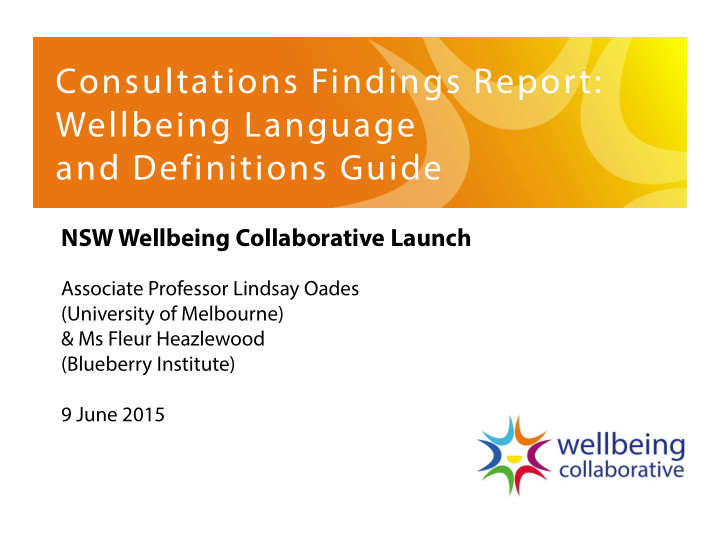



Consultations Findings Report: Wellbeing Language and Definitions Guide NSW Wellbeing Collaborative Launch Associate Professor Lindsay Oades (University of Melbourne) & Ms Fleur Heazlewood (Blueberry Institute) 9 June 2015
Wellbeing: Language & Definitions • What is wellbeing? eg. word, concept, brand, experience, state • At what level are we discussing wellbeing? eg. Individual, couple, family/team/group, organisation, city, region, nation • Is wellbeing made up of multiple parts? eg. psychological, social and emotional for Aboriginal people
A Guide on Language and Definitions • The Wellbeing Collaborative is developing a guide on language and definitions around wellbeing • Need for some common language and consistency • Need for some agreement and consistency on definitions
A Guide on Language and Definitions This will enable: – clearer understanding between stakeholders – ability to measure and evaluate wellbeing initiatives across different contexts – improved confidence and competence of people new to the language of wellbeing – reduced confusion.
Consultation process Consultation participants (50) • NSW Family and Community Services - Northern Sydney District • NSW Department of Education and Communities • Justice Health • City of Sydney • Aboriginal Affairs NSW
Consultation process • Mana Allawah Project Management Group • NSW Mental Health Commission • Uniting Care Mental Health • Transcultural Mental Health Centre, Western Sydney Local Health District
Unanimous positive response • Overall desire to improve wellbeing • Openness to guidance and expertise • Thirst for knowledge on how to improve wellbeing • Genuine interest in discussing wellbeing and collaborating with others to develop wellbeing initiatives
Unanimous positive response • Wellbeing will be improved by working together versus silos • View the formation of the NSW Wellbeing Collaborative positively • Want to be kept in the loop regarding the Wellbeing Collaborative and initiatives • Whole of government approach to wellbeing language and definitions guidance is positive and helpful
Definitions of wellbeing
Wellbeing is • Having quality of life, balance • Feeling safe and secure, place to call home • Feeling included and supported, belonging • Being respected, valued and acknowledged • Having resilience, being able to cope • Feeling understood, acceptance • Feeling happy, satisfied, content
Wellbeing is • Sense of purpose, direction, goals, personalised • Functioning, productive, participating • Empowered, control over your life, • Harmony, peace, calm • Meaningful relationships, supportive community • Positive outlook • Cultural identity • Healthy state of emotional, mental and physical being
Wellbeing is not • Physically unhealthy • Suffering • Feeling stressed, not coping, overwhelmed • Feeling devalued • Feeling unsupported • Discrimination, exclusion • Unemployment
Wellbeing is not • Isolation • Illness • Poverty • Feeling unsafe • The absence of mental illness • Depression, anxiety • Working in an unhealthy environment • Welfare
Challenges in promoting wellbeing 1. Perceived time to invest in wellbeing when workloads are already under pressure 2. Lack of confidence and the skills needed to deal with wellbeing issues that may present 3. Wellbeing can be seen as a program over and above activities providing another impost on already limited budgets
Challenges in promoting wellbeing 4. ‘If we ask about wellbeing in the workplace we will have to do something about it’ 5. Wellbeing is “policy speak” dictated by the government 6. Wellbeing is pollyanna-ish, too positive 7. Wellbeing carries stigma by association to mental illness 8. Wellbeing is not tangible enough
Developing the guide • The guide will assist people with helpful language to use in different contexts to understand wellbeing to communicate using different types and definitions of wellbeing • The guide will not be prescriptive but will provide a common vehicle for communication about wellbeing
Wellbeing Collaborative Join the Wellbeing Collaborative Network to get updates on events and other announcements. Visit the website to join. www.wbcnsw.net
Recommend
More recommend